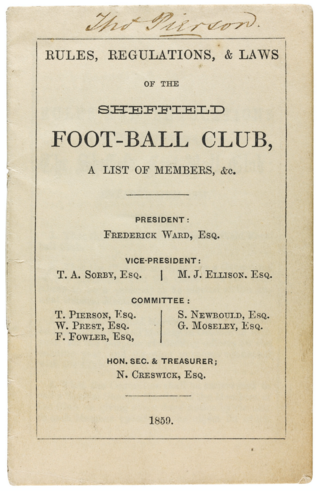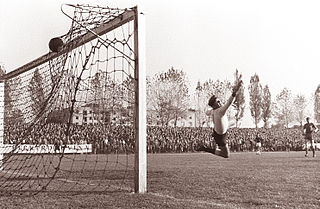
Offside is one of the laws in association football, codified in Law 11 of the Laws of the Game. The law states that a player is in an offside position if any of their body parts are in the opponents' half of the pitch, and closer to the opponent's goal line than both the ball and the second-last opponent.
The Laws of the Game are the codified rules of association football. The laws mention the number of players a team should have, the game length, the size of the field and ball, the type and nature of fouls that referees may penalise, the offside law, and many other laws that define the sport. During a match, it is the task of the referee to interpret and enforce the Laws of the Game.
The Royal Engineers Association Football Club is an association football team representing the Corps of Royal Engineers, the 'Sappers', of the British Army and based in Chatham, Kent. In the 1870s, it was one of the strongest sides in English football, winning the FA Cup in 1875 and being Cup finalists in three of the first four seasons. The Engineers were pioneers of the combination game, where teammates passed the ball to each other rather than kicking ahead and charging after the ball. With the rise of professional teams, in 1888 the Engineers joined a newly formed Army Football Association.

A throw-in is a method of restarting play in a game of association football when the whole of ball passes over the touchline. It is governed by Law 15 of the Laws of the Game. In Scotland it is known as a shy.

Ebenezer Cobb Morley was an English sportsman. He is regarded as one of the fathers of the Football Association (FA) and modern football.

The Sheffield Rules was a code of football devised and played in the English city of Sheffield between 1858 and 1877. The rules were initially created and revised by Sheffield Football Club, with responsibility for the laws passing to the Sheffield Football Association upon that body's creation in 1867. The rules spread beyond the city boundaries to other clubs and associations in the north and midlands of England, making them one of the most popular forms of football during the 1860s and 1870s.

Charles William Alcock was an English sportsman, administrator, author and editor. He was a major instigator in the development of both international football and cricket, as well as being the creator of the FA Cup.
The following are events in the 1860s decade which are relevant to the development of association football. Included are events in closely related codes, such as the Sheffield Rules. All events happened in English football unless specified otherwise.

The history of association football, more commonly known as football or soccer, stretches back to at least medieval times. FIFA cites Cuju in ancient China is the earliest form of a kicking game for which there is scientific evidence, a military manual from the Han dynasty, and it closely resembles modern association football. Similar games were played in ancient Japan, Greece, and Rome. The first written evidence of a football match came in England in about 1170.
The Combination Game was a style of association football based around teamwork and cooperation. It would gradually favour the passing of the ball between players over individual dribbling skills which had been a notable feature of early Association games. It developed from "scientific" football and is considered to be the predecessor of the modern passing game of football. It originated in Britain and its origins are associated with early clubs: Sheffield FC, The Royal Engineers AFC, Queen's Park FC and Cambridge University AFC. Each of these claimants is supported by retrospective accounts from men who were notable in the early history of football. They are considered below in the order of earliest contemporary evidence of "scientific" football playing styles.

The 1876 FA Cup final was an association football match between Wanderers F.C. and Old Etonians F.C. on 11 March 1876 at Kennington Oval in London. It was the fifth final of the world's oldest football competition, the Football Association Challenge Cup. The Wanderers had won the Cup on two previous occasions. The Etonians were playing in their second consecutive final, having lost in the 1875 match after a replay. Both teams had conceded only one goal in the four rounds of the competition prior to the final. In the semi-finals, the Wanderers defeated the Swifts and the Etonians beat the 1874 Cup winners Oxford University.
Crystal Palace F.C. was a short-lived amateur football club formed in 1861, who contributed to the development of association football during its formative years. They were founder members of the Football Association in 1863, and competed in the first ever FA Cup competition in 1871–72.
Passing the ball is a key part of association football. The purpose of passing is to keep possession of the ball by maneuvering it on the ground between different players with the objective of advancing it up the playing field.

The 1872 association football match between the national teams of Scotland and England is officially recognised by FIFA as the first international. It took place on 30 November 1872 at Hamilton Crescent, the West of Scotland Cricket Club's ground in Partick, Glasgow. The match was watched by 4,000 spectators and finished as a 0–0 draw.
Hertfordshire Rangers F.C. was a 19th-century English amateur football team based in Watford, Hertfordshire. It competed in the FA Cup and had two players represent England in international matches.

Arthur Pember was a British sportsman, stockbroker, lawyer, journalist and author, notable for serving as the first president of The Football Association from 1863 to 1867.

John Charles Thring, known during his life as "Charles Thring" or "J. C. Thring", was an English clergyman and teacher, notable for his contributions to the early history of association football.
Windsor Home Park F.C. was an amateur football club who featured in the early years of the FA Cup.

In games of association football, teams compete to score the most goals. A goal is scored when the ball passes completely over a goal line at either end of the field of play between two centrally positioned upright goal posts 24 feet (7.32 m) apart and underneath a horizontal crossbar at a height of 8 feet (2.44 m) — this frame is itself referred to as a goal. Each team aims to score at one end of the pitch, while preventing their opponents from scoring at the other end. Nets are usually attached to the goal frame to catch goalscoring balls, but the ball is not required to touch the net.

A free kick is a method of restarting play in association football. It is awarded after an infringement of the laws by the opposing team.














